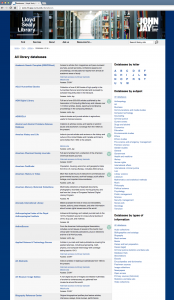We use Drupal 7 as the CMS behind our library website. It’s robust and flexible, but has a notoriously steep learning curve on the back end. One thing we struggled with at first was how best to direct our users to the databases they have access to. (At this time, CUNY doesn’t have a discovery layer, so students must find articles by choosing a database first and searching within.)
Making a good directory for our 200+ databases required getting familiar with Content Types (specifying categories of content, like ‘database’ or ‘blog post’) and Views (how these fields are presented, like displaying a URL as a link). When you make a new content type, behind the scenes, Drupal adds more tables to its core database, where every field you pick is a column and every piece of content you add is a row.
The full page of our database directory looks like this:

Each database we subscribe to has its own row of information and links, like this:


